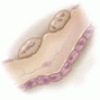More articles from Review
- Evaluation and management of pituitary incidentalomas
A surprising number of apparently healthy people harbor unsuspected pituitary tumors, which are being discovered incidentally on computed tomography and magnetic resonance imaging.
- Using biochemical markers of bone turnover in clinical practice
Although no guidelines to date recommend the widespread use of these markers in clinical practice, we believe they will eventually be accepted.
- Which patients benefit from carotid stenting? What recent trials show
Whether carotid stenting has any advantage over carotid surgery and which patients should undergo it are still topics of study and debate.
- An update on proteinuric chronic kidney disease: The dual-goal approach
To slow the progression of proteinuric chronic kidney disease, we may need to set goals for lowering both blood pressure and urinary albumin excretion, using drugs that block the renin-angiotensin-aldosterone system at multiple sites or in higher doses. However, this dual-goal approach needs to be validated prospectively.
- Nonalcoholic fatty liver disease: A manifestation of the metabolic syndrome
As we get heavier, our livers get fattier. Despite an explosion of research on nonalcoholic fatty liver disease and gains in understanding its epidemiology and pathogenesis, a number of issues remain unresolved, including how to treat it.
- Eosinophilic esophagitis: An increasingly recognized cause of dysphagia, food impaction, and refractory heartburn
This disease, which was not described as a distinct clinical entity until 1993, may be due to allergic and immune-mediated mechanisms similar to those of asthma and other atopic diseases.
- What is the proper workup of a patient with hypertension?
If we were to launch an intensive workup for every patient with high blood pressure, the cost and effort would be enormous. Fortunately, accurate blood pressure measurement, a focused history and physical examination, and a handful of basic tests are often enough.
- New asthma guidelines emphasize control, regular monitoring
The goal of asthma therapy is to achieve control, thereby reducing current impairment and future risk. Asthma control can be assessed serially by using validated instruments.
- Take charge of your e-mail!
Although e-mail is supposed to help people save time, for many it has become a burden. You can fight e-mail overload by taking steps to decrease the amount of unwanted e-mail you receive and by managing your inbox in an organized manner.
- IgA nephropathy: Challenges and opportunities
We now have a reasonably complete understanding of the pathogenesis of this disease, but its etiology remains mysterious, its therapy remains largely empiric, and its course remains hard to predict. Many opportunities exist for improvement.



